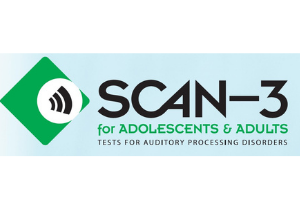Author:
Robert W. Keith, PhD
Age Range:
Individuals 13:0—50:11 years old
RTI Tiers:
Screening-1; Diagnostic-2 and 3; Supplemental-3
Completion Time:
Screener: 10—15 minutes; Diagnostic Assessment: 30—45 minutes
Scores/Interpretation:
Screening tests: norm-based criterion-referenced scores; Diagnostic tests: scaled scores, percentile ranks; Ear Advantage scores for all tests except Gap Detection
Publication Date:
2009
Battery of tests to detect auditory processing disorders in adolescents and adults.
It is difficult to differentiate auditory processing disorder from auditory comprehension skills and auditory attention diffi culties. SCAN-3 helps you identify specific auditory processing difficulties in adolescents and adults. Based on the pattern of an individual’s test results, this tool can help you plan intervention to minimize the impact of the auditory processing disorder at school, work, home, and in the community.
Content & Administration
SCAN-3 provides the following tests to help you evaluate key indicators of auditory processing ability in adolescents and adults:
Screening Tests
- NEW! Gap Detection—Indicates presence of a temporal processing problem which may influence the ability to comprehend running speech
- Auditory Figure Ground (+0 dB)—Tests ability to listen with background noise
- Competing Words (Free Recall)—Dichotic listening task (poor performance may indicate lack of maturation or abnormality of the auditory nervous system)
Diagnostic Tests
- Filtered Words—Indicates ability to process speech when the signal is distorted or compromised by a poor acoustic environment
- Competing Words (Directed Ear)—Dichotic listening task that indicates a child’s auditory maturation or developmental level
- Competing Sentences—Provides information about the maturation of the nervous system
Supplementary Tests
- Auditory Figure Ground (+8 dB and +12 dB)
- NEW! Time Compressed Sentences
Psychometric Information
SCAN-3 features updated norms and continuous normative scores across SCAN-3 Child and Adolescent/Adult editions so that you can continue to monitor progress as the child ages out of the SCAN-3 for children.
Presentation
View a Training Presentation
Questions
Frequently asked questions follow. Click on a question to see the response.
Purpose and Use
Test Content
Administration
-
When should I choose to use the supplementary subtests of the SCAN-3?
-
A student was given the SCAN-3 and the educational team was unaware that he had a concussion at the time. He has now been cleared by the medical staff and the team feels that the SCAN-3 administration is inaccurate and invalid. When can we re-administer the test without compromising our result?
Scoring
- On the SCAN-3 Competing Words – Directed Ear test, the manual states that:
- A correct response is when the child repeats the words correctly in the directed order.
- An incorrect response is one that is not in the directed order, no response or I don’t know.
If the child is meant to say ‘waste, cage’ and they say ‘waste’ only, mark ‘waste’ as correct and ‘cage’ as incorrect (no answer). What if the child responds with only ‘cage’ (i.e., only gives the left ear response)? Is this marked correct or incorrect?
Interpretation
-
I want to make sure I’m interpreting my SCAN-3 results correctly. What type(s) of information do you have to help me?
-
Can the SCAN-3 be used to try to determine whether the finding on dichotic testing is from an auditory processing disorder (APD) or cognitive disorder?
-
What criteria can be used to diagnose a child as having an auditory processing disorder (APD)?
- I am the hiring manager at a law enforcement agency. I have been using the SCAN-3:A test batteries as a screening tool for dispatcher applicants for the past several years. I have noted with regularity that the applicants who do not meet the norms on the SCAN-3:A tests do poorly in the dispatch center. As the hiring manager, I want to incorporate passing the SCAN-3:A as an essential qualification in the hiring process for dispatchers. A few questions:
- Can the SCAN-3:A be used as a tool in pre-employment?
- Was there a multicultural bias in the standardization of the SCAN-3:A? Many of our applicants are Hispanic and English is a second language.
- Was there a gender bias in the standardization of the SCAN-3:A test?
Manuals, Record Forms, & Manipulatives
-
On the Audio CD, The Filtered Words (FW) subtest sounds quiet. Is there a problem with the CD?
-
Why does the FW test appear to be so quiet?
-
The dB level of the stimuli in the Filtered Words subtest sounds noticeably “quieter” than the other subtests.
Technical Information
-
What settings should be used to be sure that the person being tested can hear the stimuli well?
-
What is an acceptable background noise level in the room where I administer the SCAN-3 and still get valid test results?
-
I put the audio CD into my CD drive and the track labels seem to be incorrect. Do I have the wrong disk?
-
In the protocol instructions, there is a figure/ground subtest that evaluates each ear individually and that there is a CD and earphones involved but where do you get these earphones and where do they plug in?






